 |
|
Astronomy & Astrophysics titles:
Resolving accretion curtains
in the asynchronous magnetic cataclysmic variable BY Cam
|
Tomography of close binary stars
BY Camelopardalis is a close stellar pair,
in which a low-mass star loses gas onto a compact white dwarf.
Using phase-resolved, medium-resolution spectroscopy and the technique of
Doppler tomography, we could resolve an extended mass flow in this peculiar
magnetic, interacting binary.
The strong magnetic field of the white dwarf of 28 MegaGauss - a thousand times
stronger than that in a sunspot - dramatically changes the structure of
the infalling mass flow. In contrast to non-magnetic cataclysmic variables (CV)
forming accretion disks, the material is usually collimated in
a focused stream and directed to one or both magnetic poles.
This structure, which at micro-arcsecond scales is not observable by
direct imaging, can be resolved by reconstructing the 2-dimensional
velocity fields from a set of spectra taken at different aspect angles.
The target binary is the
brightest member of the rare class of four known asynchronous polars, where the
rotation of the magnetic white dwarf differs by a few percent from the
orbital revolution period. The first tomographic observations of such a system
obtained during two different occasions in 1998 and 1999, revealed line emission
spread out over a large velocity range forming a crescent at negative velocities
in the Doppler maps. Location and extent of the structure in the Doppler maps
can be reproduced with a simple curtain model raised over a wide range in azimuth.
This surprising result is in stark contrast to previous observations of non-magnetic
and strongly magnetic cataclysmic variables, which preferentially accrete
either through an accretion disk or a funnelled stream, respectively.
Magnetic accretion via curtains may be a yet unobserved but important mode
of mass transfer in other types of astrophysical objects,
among them T Tauri objects or neutron stars.
At present it is not
clear whether the observed behaviour is related to the asynchronous nature of the
object or simply caused by a larger than average mass accretion rate.
Ultimate conclusion will require an extended spectroscopic campaign providing
a set of Doppler maps over the entire beat cycle of 14 days.
R. Schwarz
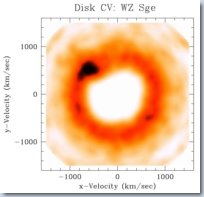
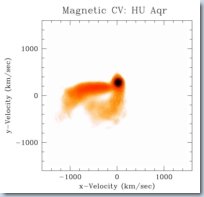 |
| As a comparision to BY Cam, two Doppler maps of a
a CV clearly showing an accretion disk (left) and a magnetic CV
(right) dominated by strong emission from the ballistic stream.
|
Publication
R. Schwarz, A.D. Schwope, A. Staude, R.A. Remillard, 2005: Doppler tomography of the asynchronous polar BY Camelopardalis
Astronomy & Astrophysics 444 (Nr. 1), p. 213
[Paper draft]
|
|
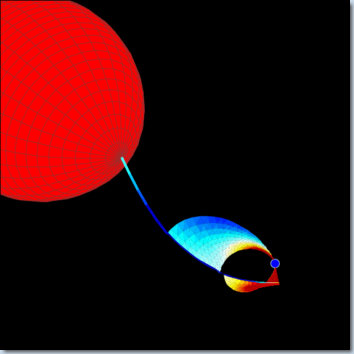
Animation of a cataclysmic variable with a magnetic white dwarf (blue circle) accreting
onto two poles via extended curtains. The colour coding represents the
line-of-sight velocities of the specific parts in the accretion flow (J. Vogel).
[MPEG 2MB] -
[zoomed-in MPEG, 900KB]
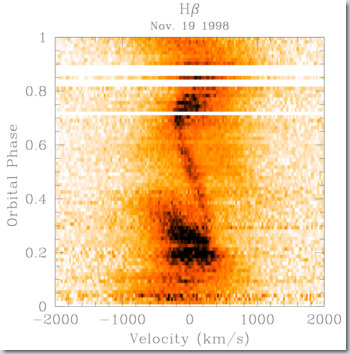
Time(phase)-resolved spectra of BY Cam's Hβ emission line profile observed in 1998.
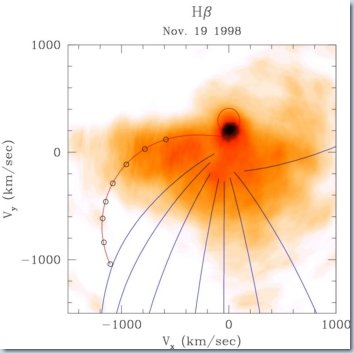
Doppler map of BY Cam computed from the above spectra. Overlayed are the locations of
the secondary star (red loop), a ballistic trajectory (red arc), and a set of magnetic
trajectories representing an extended curtain (blue).
|
|


 last change 2005 December 21, R. Arlt
last change 2005 December 21, R. Arlt


